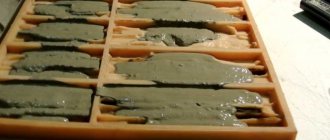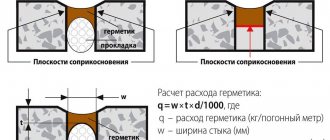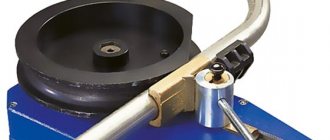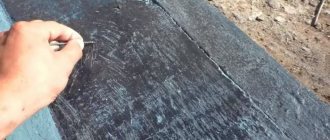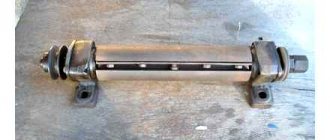How to weld asphalt at home - Metalworker's Guide
Historians claim that the first mention of something similar to asphalt concrete appeared in the 6th century BC in Babylon. But the technologies of those times were unreliable, plus unnecessarily expensive, as a result, such roads were forgotten until the twentieth century. The construction of asphalt concrete pavements in Russia began in 1928 and to this day it is predominant.
Photo of laying a country road.
What it is
Classic recipe
For preparation, we will need ordinary river or quarry sand, bitumen resin or bitumen and fine crushed stone. Equipment you will need is a metal barrel and a bucket.
It is better to cook asphalt over a fire, since using gas is unsafe and expensive.
- Initially, add crushed stone and sand in a 2:1 ratio and mix well. All this should be filled with water and hung over the fire.
- At the same time we prepare the bitumen base. To do this, take a metal bucket and heat the bitumen in it until it boils. You can add synthetic polymers as a plasticizer, but it’s cheaper to use shampoo or any detergent.
- When the resin has warmed up and the water in the barrel with crushed stone has also boiled, they need to be combined. Water is needed to ensure that the crushed stone and sand do not heat up above 100ºС. Next, this broth must be stirred, maintaining a boil until all the water has boiled away. While the solution is hot, it can be poured.
Hand laying.
Important: be careful, at 80 ºС bitumen melts, and at 100 - 120 ºС it boils. But already at 170 ºС bitumen can ignite.
Actually, to prevent such a fire, we use water.
Using old road surfaces
Rules for laying coatings
The construction of asphalt concrete pavements is a responsible matter and it is not so important whether you lay it yourself or hire professionals. Laying and acceptance of asphalt concrete pavement is carried out in accordance with SNiP 2.07.01-89, as well as a number of GOSTs.
Only a specialist can understand these documents, so we have outlined the main provisions of these norms and rules in a more understandable language.
Crumb rubber in road construction
Numerous attempts to introduce rubber into asphalts and bitumens have been going on for years.
The developers hoped to improve the properties of road mixtures, and the work of researchers from leading countries yielded encouraging results.
The dependences of the performance qualities of asphalt concrete on the quantity and size of added rubber particles were identified.
The properties affecting the durability of coatings, safety and comfort of movement have been studied.
- Crack resistance . This indicator increases by 30% when using crumbs with particle sizes up to 1 mm. The smaller the fraction, the higher this indicator. The most effective size is 0.08-0.14 mm. Small particles disintegrate and participate in the process of bitumen modification, significantly improving its properties.
- Coefficient of adhesion . On a wet surface, the use of crumbs doubles the adhesion of the fabric to the tires.
- Elasticity coefficient at low temperatures . A uniform increase in elastic deformations throughout the entire volume occurs when fine rubber crumbs are introduced into the bitumen. The effect is most noticeable at subzero temperatures.
- Noisy coverage . The noise level from the wheels decreases with the addition of a coarse fraction (2-10 mm). Such crumbs are used in the manufacture of massive rubber slabs. They are used for crossing tram and railway tracks, sports grounds, etc.
Improved road surfaces contain recycled crushed rubber in an amount of 2% of the total mass. 60-70 tons of crumb rubber per 1 km of road surface increases the service life by 1.7-2 times, which confirms the rationality of its use in road construction.
History of creation
Both scientific and implementation work was carried out in Russia (research began in the Soviet Union).
In 1991, the Ministry of Transport and Construction released a “Manual on the construction of roads and airfield pavements . The document notes the effect of introducing crushed rubber into hot mixtures on increasing friction properties and durability of the coating.
The result of the research made it possible to reduce the consumption of high-strength, difficult-to-grind crushed stone of the required quality.
The “Manual” specifies the conditions for obtaining the most dense structure: particle size ≤ 0.65 mm, optimal crumb content 5-7% by weight. Larger particles (2-8 mm) give a positive result only during the initial period of operation .
Methods of use
During the research process, methods for introducing rubber particles into asphalt concrete mixtures were developed.
"Dry" or "cold" scheme
The rubber processing product (1-2.5 mm) is added as a filler when making the mixture.
The simple and low-cost technology reduces the amount of asphalt required by replacing some of it with rubber.
Experimental roads have been built.
Disadvantages: over time, the rubber swells, the coating loosens and the crumbs erode, the canvas gradually collapses.
"Wet" scheme
Grains of 0.5-0.62 mm are introduced into the hot mixture in a special installation. In 1960, rubberized bitumen (AR) was created.
The material is prepared using the hot method and has excellent elastic properties.
Application benefits
The coating has new properties:
- service life increases by 5-10 years, the period between repairs – several times; the cost of repairs and maintenance is reduced by 10 times;
- wheel slip is reduced;
- drainage properties are improved in rain and ice;
- the coating becomes more elastic, does not crack, or sag.
Improving noise characteristics allows roads to be brought closer to residential buildings - the distance is reduced by 2 times.
The disadvantage of the technology is the high labor intensity of the process of constructing the canvas. This is explained by the fact that the characteristics of the material must be brought into compliance with existing standards.
Using crumb rubber to create “soft” asphalt
Crumb rubber is a multifunctional coating both in terms of application and technical properties. Crumb rubber asphalt is suitable for playgrounds, sports facilities, and pedestrian areas.
The durable, elastic material is called “soft” asphalt, and you can even make such a rubber coating with your own hands. The price of crumb rubber is reasonable, and the installation technology is simple and can be done by every owner.
Such asphalt does not absorb moisture and is not destroyed by rain, snow and ice.
do not lose their original stylish appearance throughout the entire period of operation (about 10 years) .
Soft asphalt is actively used in the construction of objects:
- running tracks, sports grounds;
- tennis courts, rooms with special floor requirements;
- children's play areas, local areas;
- park alleys, pedestrian paths on the streets;
- car parking.
A method for laying rubber slabs in a seamless manner has been developed. Brightly colored laying gives the area an attractive look .
The main condition for using this technology is not too high mechanical loads on the surface.
All consumers note the resistance of rubber coatings to abrasion. The material also resists exposure to aggressive environments.
An alternative to seamless asphalt is roll or modular crumb coatings. They are much easier to install, and they look just as good.
Main coating characteristics and cost
The main properties of a soft coating are reliability, strength, and durability.
Among the qualities of the material, consumers highlight the following:
- safety from injuries - due to the anti-slip effect and elastic properties;
- hygiene, environmental safety;
- aesthetics;
- ease of installation.
The surface of the coating is smooth and elastic, absorbs dynamic loads .
It does not collect dust and is easy to clean with a stream of regular water.
Customers are attracted by the low cost of this recycled product, which, moreover, has a convenient form of delivery - in bags.
Approximate prices in rubles for seamless coating of the popular Finish brand.
| Name | Thickness, mm | Coverage area, price | |
| 30-100 | 100-1000 | ||
| Finish | 10 | 1200 | 900 |
| 15 | 1300 | 1000 | |
| 20 | 1400 | 1100 | |
| Finish Premium EPDM | 10 | 2300 | 1900 |
| 15 | 2500 | 2000 | |
The final cost is clarified when a specialist visits the site.
Installation
Installation is easy to do yourself on any base.
If a section of a track or platform is damaged, it is replaced with a new one without dismantling the entire structure.
Installation steps:
- preparation of the base - cleaning, priming with a polyurethane compound;
- mixing components;
- pouring the mixture onto the prepared base.
The result is an even, seamless coating. Small areas are laid manually; for larger areas, special equipment is used .
Asphalt laying technology
Simply spreading a hot resinous mixture on the ground will not work. The area for asphalting should be prepared in advance. It is necessary to carefully consider where the paths will be located. It should be borne in mind that it is undesirable to plan them next to a vegetable garden or flower bed: the asphalt surface evaporates substances harmful to health. Crops will accumulate these fumes.
The asphalt is laid on a flat, compacted surface. Without the right foundation, you won’t be able to build a path.
Designing a site to be covered with asphalt
Considering the odors that asphalt emits, I recommend making an asphalt covering at the entrance to the house for a car. Similar paths can be laid between the buildings on the site: from the mansion to the summer kitchen, change house, garage, bathhouse, toilet, etc.
Before excavation work begins, markings are made and the thickness of the crushed stone that will serve as the base of the path is determined. For pedestrian paths, a layer of asphalt of 7 cm is suitable. The road for a car needs to be made more solid, at least 15 cm thick. The crushed stone base for such a road should have a height of about 40 cm.
Excavation work: soil removal, leveling and compaction
How to lay asphalt correctly?
Asphalt concrete, or asphalt, is a multi-component mixture of bitumen, sand, gravel or crushed stone. To improve its technical characteristics or to reduce cost, its composition may include additional fillers such as cement, crumb rubber, mineral and polymer additives.
New asphalt from old
Recently, more and more often, after repairing the road surface by specialized services, old (cut) asphalt concrete is left behind. It turns out that you can also use it to make high-quality road surfaces. And all that is necessary for this is to break the pieces of old asphalt into small fractions and lay them in the required place in a layer of about 10 cm. Finally, the rocky base should be rolled with a road roller. It should be noted that these works should be carried out in warm weather so that the resin present in the cut asphalt melts a little and fills all the voids.
And in the end we offer the corresponding video:
If you liked the material, I will be grateful if you recommend it to friends or leave a useful comment.
How and from what can you make asphalt yourself?
Using a similar technology, you can make material for garden paths with your own hands. At home, it will not be possible to create asphalt that can become a surface for heavily loaded roads. However, such material is quite capable of strengthening garden paths or the entrance to the site. For it you need to find the following ingredients:
- sand;
- crushed stone or gravel;
- bitumen resin in solid form.
In addition, you will need tools to produce homemade asphalt. You need to stock up on a wide container for mixing the components, a metal barrel, a bucket, a mesh for sifting sand, and a shovel.
Components and production of hot asphalt
The ingredients described above are suitable for hot asphalt. It is recommended to add polymeric materials to the mixture.
To create asphalt at your dacha, you will need the appropriate equipment: a hearth with a fire, a container for mixing components, tools for mixing asphalt. A metal barrel of machine oil or diesel fuel is suitable as an asphalt mixer. The asphalt cooking process can be seen in the video below. It consists of the following steps:
>
What is cold asphalt and how to make it?
A cold analogue of a homemade mixture for covering garden paths is a material that appeared in our country quite recently. Its main advantage is the ability to lay asphalt even in winter: it is suitable for work at 20 degrees below zero.
The composition contains special bitumen with a high degree of viscosity. In addition, the mixture contains high-quality plasticizers and modifiers that work on the “cold welding” principle. This material allows you to create paths in the country or near the house with a long service life.
It is impossible to make a cold mixture for paths with your own hands. This process requires the use of high technology. However, every summer resident has the opportunity to buy a ready-made mixture for cold asphalt paving.
New asphalt from old
With the right approach, new asphalt can be welded from old. Road workers throw out such material near areas being repaired. There is no need to pay for it, so making new asphalt from used asphalt is one of the most economical options.
To create a hot mixture you will need 100 kg of old coating, 10 kg of bitumen, and the same amount of resin. The process consists of the following steps:
- Asphalt grinding. The mixture particles should not be larger than 40 mm. The crushed material is poured into a homemade hot “asphalt mixer”. 70 liters of boiling water and sand are added there.
- Cooking new material. The contents of the barrel are heated to a boil and cooked for several hours.
- Production of the binding component. Resin and bitumen, taken 10 kg each, are boiled in a metal bucket. The hot mixture is poured into an “asphalt mixer” and mixed. The finished asphalt can be immediately laid on the prepared area.




